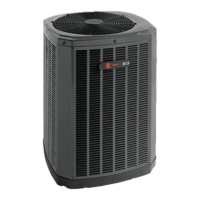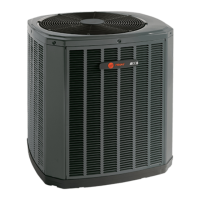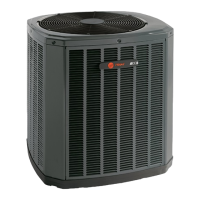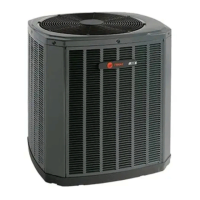
Do you have a question about the Trane 4TWR6 and is the answer not in the manual?
General safety warnings for qualified personnel.
Warnings for working with live electrical components during service.
Safety guidelines for R-410A refrigerant and POE oil.
Caution when opening the liquid line service valve.
Ensure existing refrigerant lines are brazed, not soldered.
Warning about hot compressor dome temperatures.
Table detailing unit dimensions and estimated weights by model.
Maximum refrigerant line length, vertical change, and connection sizes.
Clearance requirements for airflow and service access.
Precautions for snow accumulation and freezing temperatures.
Requirement for salt shields in coastal areas.
Steps to inspect and remove the unit from its packaging.
Guidelines for installing the unit on a support pad.
Table detailing line and valve connection sizes by model.
Information on factory system charge and verification methods.
Guidance on measuring line length and lift for charging.
Importance of insulating the vapor line and avoiding direct contact.
Precautions when reusing existing refrigerant lines for retrofits.
Preventing noise transmission via vibration isolation for lines.
Securing lines to joists/walls and avoiding ductwork contact.
Steps for preparing and brazing refrigerant lines.
Purging, brazing, and filter drier installation steps.
Procedure for pressurizing and checking refrigerant lines for leaks.
Steps to evacuate the system using a micron gauge.
Procedure for opening the gas service valve.
Procedure for opening the liquid service valve with caution.
Table of maximum wire lengths for low voltage wiring.
Wiring diagrams for thermostats and air handlers.
Information on defrost control settings and checkout.
Warnings and compliance for high voltage power supply.
Recommendation for installing a disconnect switch.
Requirements for grounding the outdoor unit.
Step-by-step procedure for starting the system.
Guide to measuring temperatures for charging.
Method for charging in cooling mode above 55°F.
Charts for calculating subcooling corrections based on line length and lift.
Using charging charts and tables to determine final subcooling.
Adjusting refrigerant level and verifying performance.
Weigh-in method for charging in heating mode below 55°F.
Stabilizing system and checking subcooling in heating mode.
Final inspection and operational checks before completion.
System faults and potential causes for refrigerant and electrical issues.












